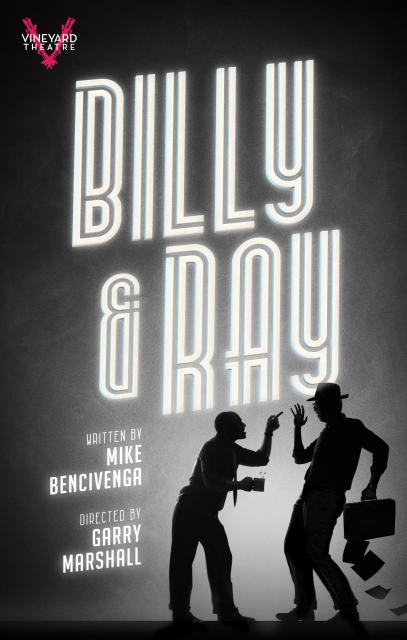
It’s hard for us to imagine a time when film noir was considered daring and even dangerous. We’ve seen so many parodies of men in fedoras with cigarettes hanging out of their mouths, growling “Stick with me, Baby.” Billy & Ray is the story behind the story, the tale of how the renowned writer/director Billy Wilder (Vincent Kartheiser) teamed up with novelist Raymond Chandler (Larry Pine) to create what became a movie classic.
It was not an easy collaboration. Wilder was Viennese, loquacious, charming and fast paced, a veteran of the Hollywood studio scene. Chandler was stolidly American, plodding, bad tempered, and inexperienced at screen writing. Both drank too much; Wilder very openly, Chandler out of a bottle in his briefcase. They disagreed on nearly everything: sex, marriage, the very air they breathed. The conflict between these two stubborn, opinionated men is at the core of the play. Written by Mike Bencivenga, witty repartee and zingy one liners often added fuel to the fire. More banter, more verbal give and take between these men who were both such gifted wordsmiths would have been fitting and appreciated.
Noted director Garry Marshall wisely keeps things moving at a fast pace; it’s easy to get bogged down in what is essentially two people talking in a room. A delightful surprise is Sophie Von Haselberg as Helen, Billy’s long-suffering assistant. She moves with ease and grace through the maze of Wilder’s demands, serving as bartender, answering service, and snappy girl Friday. The energy level on stage goes up every time Von Haselberg enters the scene. True, she is blessed with the appealing visage of her famous mom, Bette Midler, but she brings a panache all her own to the stage. It will be a pleasure to see her in a larger role.
Drew Gehling also adds style as producer Joe Sistrom, who will take a bath financially if the movie doesn’t make it onto the screen.
Scenic designer Charlie Corcoran’s interpretation of a 1940’s Hollywood studio bungalow is pitch perfect. Complete with turquoise walls, glamour pics prominently displayed, big green ferns and large windows to let in the California light, it looks lived in but au courant. Costume designer Michael Krass has not only captured the period with seamed stockings and text book silhouettes, he’s also made the most of Von Haselberg’s coloring and figure, giving her several attractive outfit changes, the most striking of which is a pink suit which conveys the both the climate and Helen’s cheery attitude. When asked why she stays with the overbearing Wilder, she replies “I love the movies!” Kartheiser is much to be praised for tackling a role so different from his “Mad Men” character, Pete Campbell, that it will take fans a moment to recognize him, and for attempting the difficult Viennese accent. Pine continues to add to his already impressive theater credentials with his brooding performance. The swing music used in the production is evocative of the era, and brightens the proceedings; kudos to sound designer David Van Tieghem. Marshall has added some clever touches; as the production begins, loud voices are heard arguing in the dark, signaling the passions about the work at hand. Helen is hiding under a desk, which gives the audience a laugh. In explaining over the phone how to find the studio, Helen assures the caller that he can’t miss it. There are huge gates, and yes, it will say Paramount Pictures outside. More such humorous touches would have been welcome; after all, the creator/producer of “Happy Days,” “Laverne & Shirley,” and “Mork & Mindy” knows how to get the laughs. This is a show which would have benefitted from more of the quirky fun for which Marshall is justly famous; a few screwball moments would have livened things up.
Billy expresses the belief that “The real world is dark and dingy and dirty.” Film noir was the ideal medium with which to show the movie-going public a slice of the underbelly of life. Need it be said that the 1940’s was the perfect time to depict the evil that seemed to be taking over the world? “Double Indemnity” was a reflection of the lying, brutality, and lack of concern for human life of that era. Wilder not only wanted to explore a different genre, he also felt strongly that his genius shouldn’t be subject to the whim of those who controlled what the public was allowed to see. Censors still exist; in some cases, they protect us, and in others, they stifle creativity.
The question of how far to go to preserve our right to freedom of expression is still being debated today. With their hard-won fight, Wilder and Chandler put a chink in the armor of censorship; the first production wrought from their collaboration was nominated for nine Academy Awards; and today, “Double Indemnity” is hailed as one of the great movies of our time.
